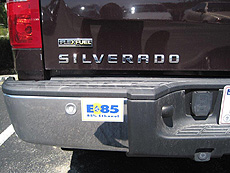Maintaining a sustainable vehicle fleet at Fermilab
 |
| Trucks that run on E-85 are one of several types of alternative-fuel vehicles in the Fermilab fleet. Photo: Eric Korzeniowski, ESH&Q |
The operations and business of Fermilab require motor vehicles. From vans to pickup trucks to buses, each vehicle has a specific purpose. Fermilab evaluates the 193-vehicle fleet for efficiency on a routine basis. This contributes to decreasing Fermilab's overall carbon footprint.
Fermilab exceeds federal environmental regulations for fleet management. Our Site Sustainability Plan sets specific fleet management goals regarding increasing alternative fuel consumption, reducing petroleum consumption, and making all light-duty vehicle purchases alternative fuel vehicles. These goals are based on federal regulations.
Fermilab currently uses three types of fuel: unleaded gasoline, E85 and biodiesel. The fleet is predominantly light trucks: pickup trucks, small SUVs, and compact and full-size vans. We also operate approximately 20 heavy-duty trucks (fire trucks, tractors and dump trucks), a few medium-duty vehicles and four sedans.
Fermilab's Fleet Utilization Committee evaluates these vehicles and, in conjunction with grass-roots efforts, has significantly contributed to making the fleet its most efficient size. Transportation Services assists employees in procuring the right-sized vehicle for the job as well as ensuring the environmental requirements are met in the best way possible. The no idling policy also contributes to decreasing vehicle emissions.
The road to a greener fleet at Fermilab starts with reducing how much petroleum we use. To that end, we use gasohol (10 percent ethanol and 90 percent unleaded gasoline), E85 fuel and biodiesel. We also purchase flexible-fuel vehicles that use E85 fuel. These are the main alternative-fuel vehicles available as light trucks.
When we first began purchasing vehicles operating on alternative fuels, we didn't have the infrastructure to provide the alternative fuel for such vehicles. But with the assistance of some grant funding from DOE, we were able to add an E85 fueling system. At one time we operated vehicles that ran on compressed natural gas, and a collaboration with NICOR helped provide the needed infrastructure, but the bi-fuel compressed natural gas system was phased out as the manufacturers stopped selling bi-fuel trucks and supplying parts.
We have stayed the course with E85, biodiesel and a few hybrids. We look forward to the prospects of new-technology vehicles that will fit into our fleet. Vehicle fuels in our not too distant future will most likely include a new breed of electrics, plug-in hybrids, hydrogen, fuel cell and maybe even some high-tech pedal cars. Stay tuned!
—George Davidson
|